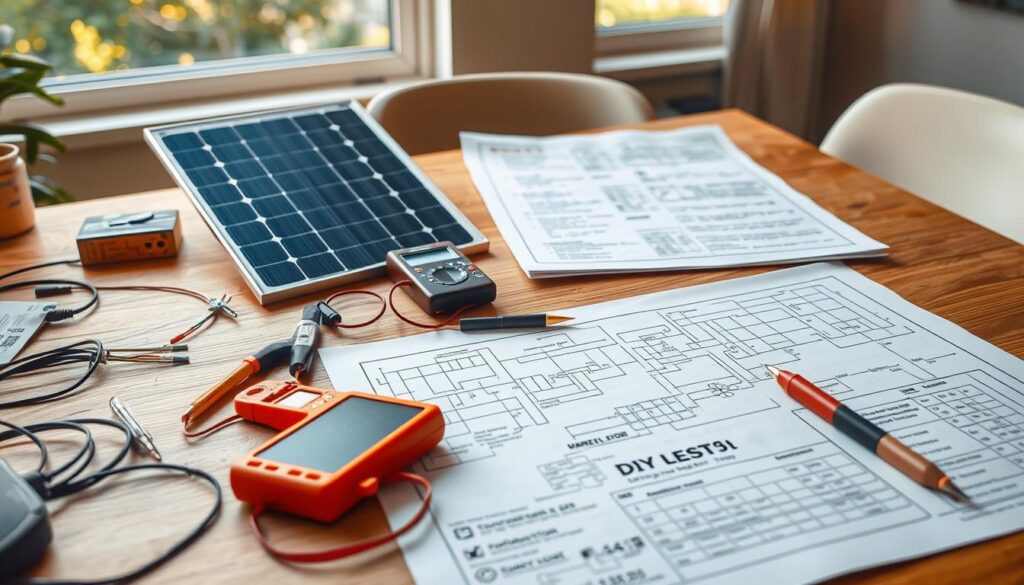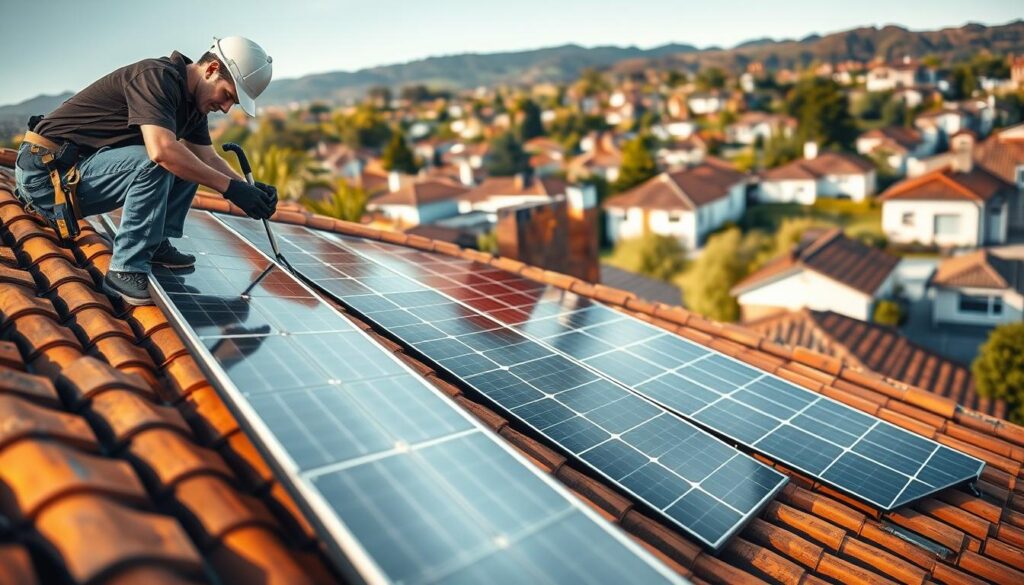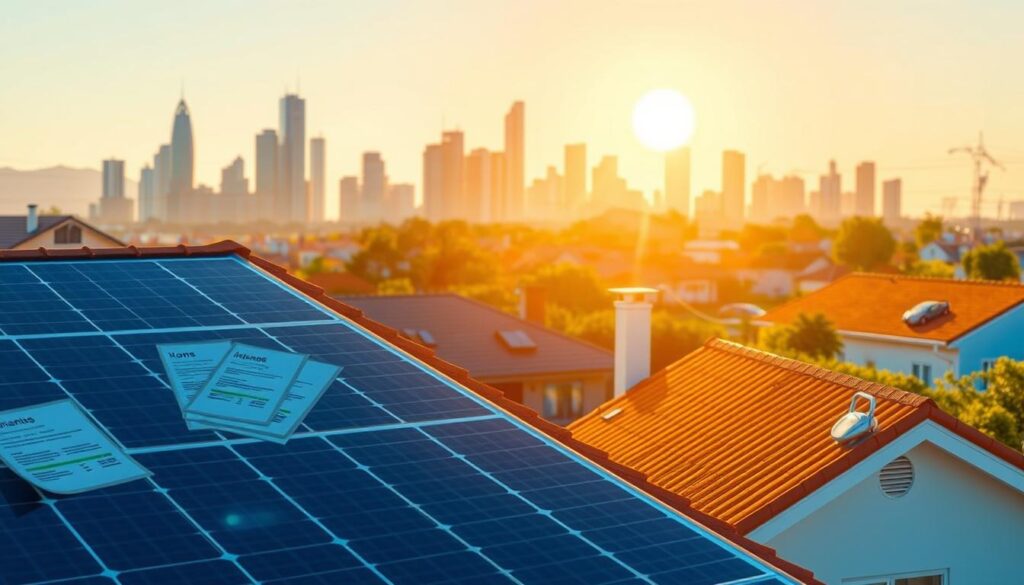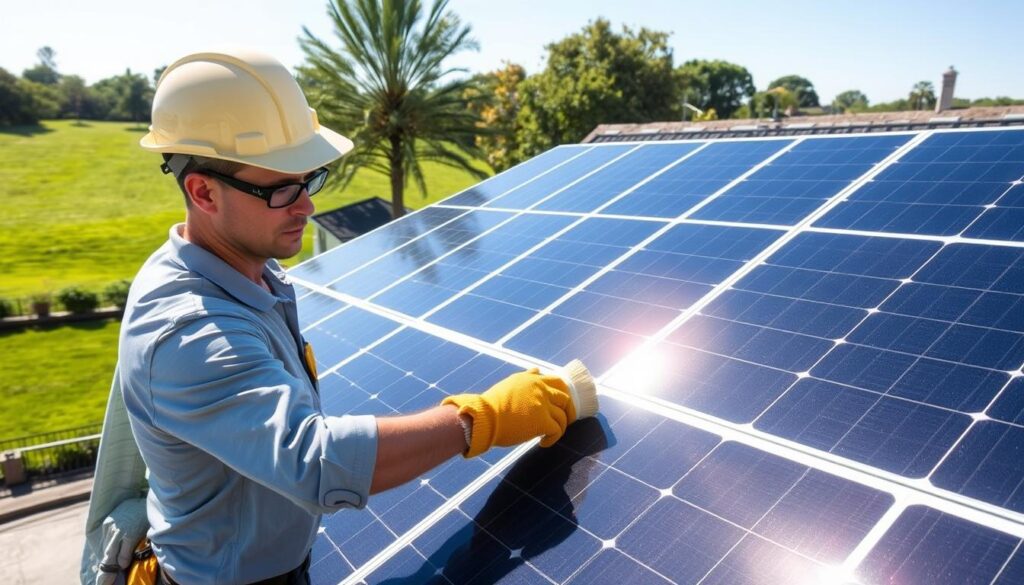Renewable energy is reshaping how we power our lives, and solar panels are at the forefront of this transformation. Over the past decade, advancements in technology have made solar energy more accessible and affordable than ever before. Hundreds of thousands of installations across the country highlight its growing popularity.
Switching to renewable energy not only reduces monthly utility bills but also minimizes your environmental footprint. With costs dropping by more than 50% since 2008, it’s now a viable option for many households. This guide will walk you through the benefits and steps to harness the power of the sun for your needs.
Key Takeaways
- Solar panels have become more affordable and efficient over the years.
- Renewable energy can significantly lower utility bills and environmental impact.
- Hundreds of thousands of installations highlight widespread adoption.
- Advancements in technology make solar energy a practical choice.
- Switching to solar can lead to long-term savings and sustainability.
Understanding Home Solar Cells and Renewable Energy
Harnessing the sun’s power has become a game-changer for modern energy needs. By converting sunlight into electricity, solar panels offer a clean and efficient way to power your daily life. This section breaks down the basics of how these systems work and why they’re a smart choice for homeowners.
What Are Home Solar Cells?
At the heart of every solar system are photovoltaic cells. These cells, often made of silicon, absorb sunlight and convert it into direct current (DC) electricity. This process, known as the photovoltaic effect, is the foundation of modern solar technology.
When multiple cells are connected, they form a panel. These panels are then combined into an array, which can generate enough power to meet your household’s needs. The result? A reliable source of clean energy that reduces your reliance on traditional grids.
How Solar Energy Fuels Your Home
Once the panels generate DC electricity, an inverter converts it into alternating current (AC), the type of power used in most homes. This energy can then power your appliances, lights, and more. Excess electricity can even be stored in batteries or fed back into the grid for credits.
Going solar isn’t just about saving money—it’s about embracing a sustainable future. With advancements in technology, these systems are more efficient and affordable than ever. By making the switch, you’re not only cutting costs but also contributing to a healthier planet.
Benefits of a home solar cell Installation
Investing in clean energy solutions can transform your household’s energy dynamics. By reducing reliance on traditional power sources, you can enjoy significant financial and environmental rewards. Let’s explore how these systems can benefit you.
Energy Cost Savings
One of the most immediate benefits is the reduction in your monthly utility bill. By generating your own power, you can cut down on electricity costs. Many homeowners report savings of up to 50% on their energy expenses.
While the upfront cost of installation may seem high, federal incentives and declining fees make it more affordable. For example, the federal tax credit allows you to claim 30% of the total installation cost. Over time, these savings add up, making it a smart long-term investment.
Positive Environmental Impact
Switching to renewable energy also has a profound effect on the environment. By reducing greenhouse gas emissions, you contribute to cleaner air and a healthier planet. Each kilowatt-hour generated by your system replaces energy that would otherwise come from fossil fuels.
Additionally, many states allow you to sell excess energy back to the grid. This not only offsets your utility costs but also promotes wider adoption of clean energy. It’s a win-win for your wallet and the environment.
In summary, installing a solar system offers both economic and ecological advantages. From lowering your bill to reducing your carbon footprint, the benefits are clear. Make the switch today and start reaping the rewards.
Planning Your DIY Home Solar Project
Taking control of your energy future starts with careful planning and understanding your unique requirements. A well-designed system ensures you meet your energy goals while staying within budget. Let’s break down the essential steps to get started.

Assessing Your Energy Needs
Before diving into your project, it’s crucial to evaluate your current energy usage. Review your utility bills to understand your monthly consumption in kilowatt-hours (kWh). This data helps you design a system that matches your needs.
Consider factors like seasonal changes and future growth. For example, if you plan to add an electric vehicle or expand your household, your energy needs may increase. Tools like online energy calculators can simplify this process.
Determining the Right System Size
Once you know your energy consumption, the next step is calculating the appropriate system size. A larger system generates more power but also comes with higher upfront costs. Balance your needs with your budget to find the right fit.
Online tools and professional consultations can help you estimate the ideal size for your project. Remember, a well-sized system maximizes efficiency and savings over time.
By carefully planning your DIY energy project, you can create a solution that meets your household’s demands and aligns with your sustainability goals. Start today and take the first step toward energy independence.
Types of Solar Power Systems for Your Home
Choosing the right energy setup can make all the difference in your sustainability journey. Whether you’re looking to reduce your reliance on the grid or achieve complete independence, understanding your options is key. Let’s explore the two main system types and how battery storage can enhance your setup.
Grid-Tied vs. Off-Grid Solutions
Grid-tied systems are the most common choice for homeowners. They connect directly to the utility grid, allowing you to draw power when needed and sell excess energy back for credits. This setup is cost-effective and requires no battery, making it ideal for those with reliable grid access.
On the other hand, off-grid systems are designed for remote locations or those seeking complete energy independence. These setups rely on battery storage to store excess energy for use during cloudy days or outages. While more expensive, they offer unparalleled freedom from utility companies.
Exploring Battery Storage Options
Battery storage plays a crucial role in both grid-tied and off-grid systems. For grid-tied setups, it provides backup power during outages, ensuring your appliances stay running. In off-grid systems, it’s the backbone of your energy independence, storing power for when the sun isn’t shining.
Modern battery technologies, like lithium-ion, offer high efficiency and long lifespans. They’re a smart investment for anyone looking to maximize their solar power system’s potential. Whether you’re grid-tied or off-grid, adding storage can enhance your energy resilience and savings.
By understanding these options, you can choose the system that best fits your lifestyle and energy goals. From cost-effective grid-tied setups to fully independent off-grid solutions, the right choice is out there.
Step-by-Step Guide to Solar Panel Installation
Proper preparation and installation are key to maximizing your energy system’s potential. Whether you’re tackling this project yourself or working with a company, following a structured approach ensures success. Let’s dive into the essential steps to get your system up and running efficiently.

Preparing Your Roof and Site
Start by assessing your roof’s condition. Ensure it’s structurally sound and free from damage. A professional inspection can identify any issues that need addressing before installation. If your roof requires repairs, complete them beforehand to avoid complications.
Next, evaluate your site’s sun exposure. The ideal location receives direct sunlight for most of the day. Use tools like solar pathfinders to analyze shading and determine the best placement for your panels. This step is crucial for maximizing energy production.
Finally, secure the necessary permits. Local regulations vary, so check with your city or county for specific requirements. Most areas mandate permits for electrical work and structural changes. Working with a reputable company can streamline this process, as they often handle permit applications.
Installing the Panels Effectively
Begin by mounting the racking system on your roof. This framework holds the panels in place and ensures they’re angled correctly for optimal sun exposure. Use safety equipment like harnesses and hard hats to protect yourself during this step.
Once the racking is secure, attach the panels. Follow the manufacturer’s instructions carefully to avoid damage. Modern technology has made panels lighter and easier to handle, but precision is still essential for proper alignment.
Connect the panels to the inverter, which converts the energy into usable power. Position the inverter close to the panels to minimize energy loss. After wiring, test the system to ensure everything functions correctly. If you’re unsure about any step, consult a professional company for assistance.
By following these steps, you can confidently install your energy system and enjoy the benefits of clean, renewable power. With careful planning and attention to detail, your project will be a success.
Evaluating Solar Panel Efficiency and Technology
Understanding the efficiency of modern energy systems is crucial for maximizing their potential. With advancements in technology, it’s easier than ever to find solar solutions that meet your needs. This section dives into the metrics and technologies that determine how effectively these systems convert sunlight into usable power.
Efficiency Metrics to Consider
One of the most important factors to evaluate is the efficiency rating. This metric measures how much sunlight is converted into electricity. According to the National Renewable Energy Laboratory, the most advanced panels can exceed 22% efficiency.
Temperature also plays a role. For every 4°F increase above 77°F, standard panels may produce 1% less electricity. Proper thermal management is essential to maintain optimal performance.
Choosing the Right Technology for Your Project
When selecting a system, consider the type of panels available. Monocrystalline panels, for example, offer higher efficiency but come at a higher cost. Polycrystalline panels are more affordable but slightly less efficient.
Use source data from reputable labs and manufacturers to compare options. Look for panels with warranties guaranteeing at least 80% production capacity over 25 years. This ensures long-term reliability.
To find solar solutions that balance cost and performance, consult expert recommendations and online tools. These resources can help you make an informed decision tailored to your specific project.
Cost Considerations and Financing Your Solar Project
Understanding the costs and financing options is essential for a successful energy project. While the initial price may seem high, the long-term savings and environmental benefits make it a worthwhile investment. This section breaks down the financial aspects, helping you make informed decisions.

Upfront Costs Versus Long-Term Savings
The upfront price of a system varies depending on size, location, and technology. On average, a 6kW system costs between $14,100 and $21,240 before incentives. However, federal tax credits can reduce this by up to 30%, making it more affordable.
Over time, the savings on your monthly utility bill can offset the initial investment. For example, a 7.2kW system with an installed cost of $30,240 can save you $7,633 over 20 years. The payback period is typically around 10 to 15 years, after which you’ll enjoy free energy for decades.
| State | Average System Cost (5kW) | Cost per Watt | Estimated 20-Year Savings |
|---|---|---|---|
| California | $17,356 | $3.47 | $8,500 |
| Florida | $16,074 | $3.21 | $7,200 |
| Texas | $16,683 | $3.34 | $7,000 |
| New York | $23,279 | $3.47 | $9,000 |
Tax Incentives and Rebates in the U.S.
One of the biggest advantages of going solar is the availability of tax incentives and rebates. The federal solar tax credit allows you to deduct 30% of the system’s cost from your income taxes for installations between 2022 and 2032. For a $30,000 system, this translates to $9,000 in savings.
Many states also offer additional incentives. For example, California’s Self-Generation Incentive Program (SGIP) provides rebates for battery storage systems. These programs make it easier to manage the upfront price and accelerate your return on investment.
Financing options like solar loans and leases are another way to reduce initial costs. Personal loan rates range from 6% to 36%, while home equity loans often have lower rates. By exploring these options, you can find a plan that fits your budget and energy goals.
Maintenance and Monitoring of Your Solar Energy System
Ensuring your energy system operates at peak performance requires consistent care and attention. Regular maintenance and monitoring not only extend the lifespan of your investment but also maximize efficiency. Let’s explore how you can keep your system running smoothly for years to come.

Routine Inspection and Cleaning
Start with a visual check of your solar array every few months. Look for debris, dirt, or damage that could affect performance. Cleaning your panels 2 to 4 times a year is recommended, especially after heavy snowfall or storms.
Use a soft brush or hose with lukewarm water to remove dirt. Avoid hot water, as extreme temperature changes can cause cracking. If your panels are hard to reach, consider hiring a professional cleaning service.
Inspect the inverter for error messages or unusual noises. This device is crucial for converting energy, so addressing issues early can prevent bigger problems. Keep the area around the inverter clear for proper ventilation.
Remote Monitoring and Performance Checks
Modern systems often come with remote monitoring tools. These allow homeowners to track energy production and system health in real time. If you notice a drop in output, it could indicate a need for maintenance or repairs.
Check your monitoring app or dashboard regularly. Look for trends in energy generation and compare them to past performance. Sudden changes may signal issues with the inverter or storage components.
Set up alerts for critical system events, like low production or equipment failures. This proactive approach ensures you can address problems quickly, minimizing downtime and maximizing efficiency.
By following these simple steps, you can keep your energy system in top shape. Regular care not only protects your investment but also ensures you continue to enjoy the benefits of clean, reliable power.
Case Studies and Real-World Examples
Real-world examples show how renewable energy transforms lives and communities. From reduced utility bills to environmental benefits, these stories highlight the power of clean energy. Let’s explore how innovative designs and smart configurations are making a difference.
Success Stories from Homeowners
Take the Lavallee family in Rhode Island, for instance. Their 9.5 kW energy system saves them $3,845 annually, with a projected return on investment in just six years. By harnessing the sun’s power, they’ve significantly reduced their reliance on traditional grids.
In California, a family saw a 70% reduction in their electricity bills after installing a 5 kW solar panel system. These case studies demonstrate how tailored designs can maximize efficiency and savings.
Lessons Learned and Expert Advice
Experts emphasize the importance of optimal placement and system sizing. For example, a school in New York strategically placed panels to overcome shading challenges, reducing energy expenses significantly. Proper planning ensures maximum exposure to the sun and long-term benefits.
Another key lesson is the value of monitoring tools. Modern energy systems come with remote tracking features, allowing homeowners to identify and address issues quickly. This proactive approach ensures consistent performance and longevity.
By learning from these case studies, you can design a system that meets your needs and maximizes savings. Whether it’s reducing bills or promoting sustainability, the possibilities are endless.
Conclusion
Embracing renewable energy is a smart step toward a sustainable future. By harnessing the power of the sun through proper solar installation, you can achieve significant long-term savings and reduce your environmental impact. Every panel home can benefit from this approach when paired with careful planning and expert guidance.
From lower utility bills to a smaller carbon footprint, the advantages are clear. The journey to renewable energy is not just about technology—it’s about making a positive change for your household and the planet.
Ready to take the next step? Explore your options and start your project today. The future of clean, reliable energy is within your reach.
